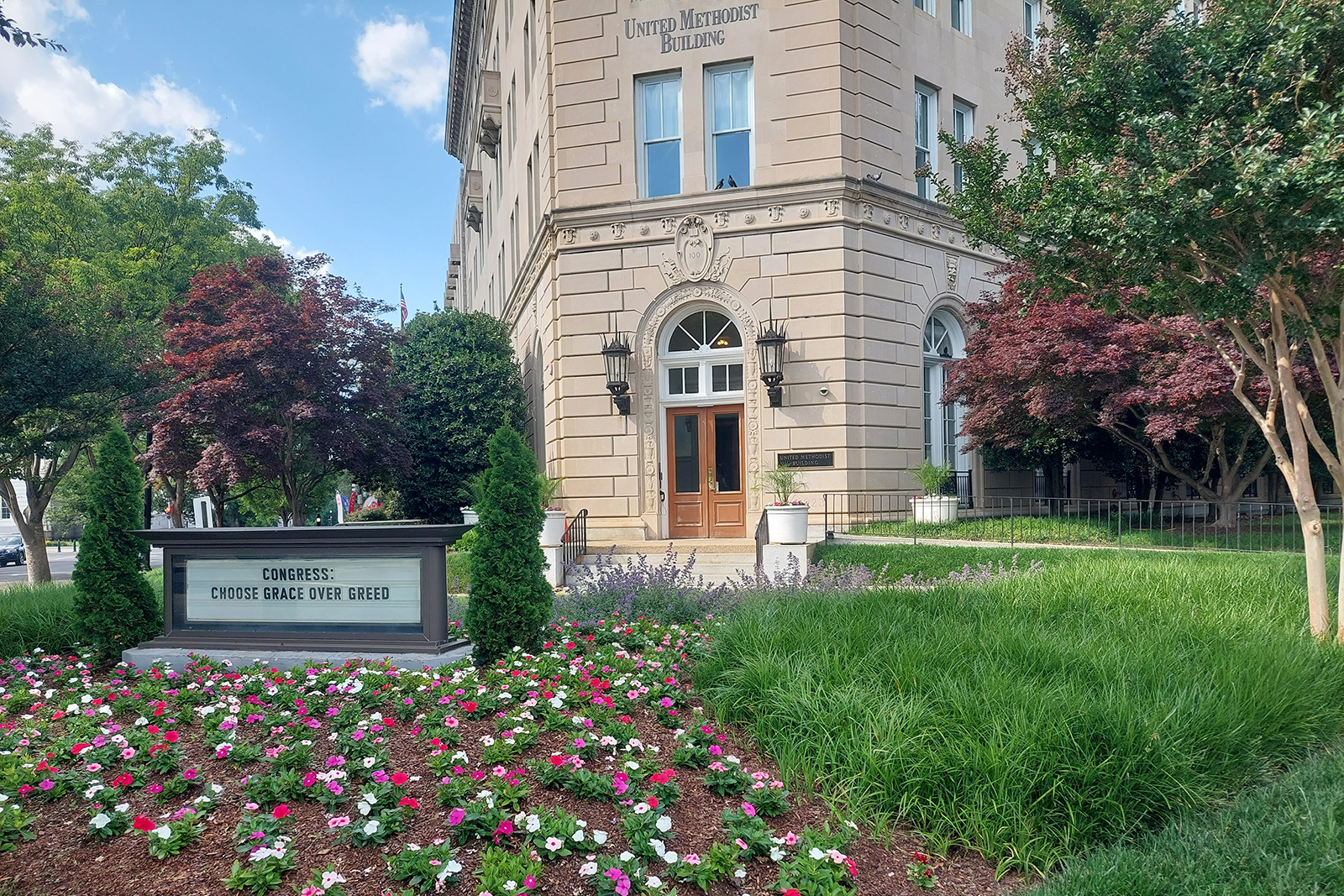
WASHINGTON (RNS) — There is no shortage of impressive buildings dotting Capitol Hill: the U.S. Capitol with its shining dome, the Library of Congress topped by a golden flame, the U.S. Supreme Court and its towering pillars.
But on the northeast corner of the Capitol complex is an unassuming building sandwiched between the Supreme Court and U.S. Senate offices. Visitors who notice it at all usually do so because of its church sign, which often features a word or phrase that is surprisingly relevant to the political news cycle.
The sign belongs to the United Methodist Building, the only nongovernmental building on Capitol Hill and one imbued with a rich history of religion, politics and activism. Something of a monument to mainline Christian, ecumenical and interfaith influence in Washington, the building has stood for 100 years, an anniversary celebrated Thursday (Sept. 26) with a special event featuring Pulitzer Prize-winning poet Jericho Brown.
John Hill, then-interim general secretary of the United Methodist Church’s General Board of Church and Society, reflected in May on the significance of the structure and its location. “Every day, when I walk into our offices at the United Methodist Building in Washington, D.C.,” he said during a presentation at the UMC’s General Conference, “I am awestruck by the wisdom of our Methodist forebears who boldly positioned this sacred place directly across from the U.S. Capitol, this place set apart for work, worship and witness to the redeeming power and promise of the gospel of Jesus Christ.”
That work and witness have often involved activism. According to the Rev. Bonnie McCubbin, director of museums and pilgrimage for the Baltimore-Washington Conference of the UMC, the building has had an advocacy-minded edge since it was first conceived in the 1920s. It was originally a project of the Board of Temperance, Prohibition and Public Morals, which emerged out of a Methodist women’s organization that campaigned in support of prohibition, because, according to McCubbin, they “were tired of seeing their brothers and uncles and sons and husbands coming home drunk.” They also opposed lynching, child labor and illiteracy, among other causes.
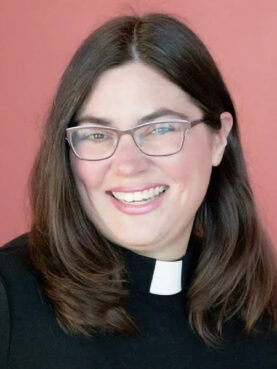
The Rev. Bonnie McCubbin. (Courtesy photo)
The building’s penchant for ecumenism was also there from the start. McCubbin said the building, constructed with Indiana limestone in an Italian Renaissance style, was dedicated in 1923 by former Secretary of State William Jennings Bryan, who had been a candidate for moderator of the Presbyterian General Assembly that year and served on the temperance board of the Federal Council of Churches — the precursor to the National Council of Churches.
But McCubbin, who also works as an archivist for the conference, noted the building was arguably an act of protest in and of itself, as it was “entirely funded by women.”
“Women who didn’t yet have a right to vote, women who didn’t yet have the ability to have their own bank account, women who were not allowed to manage their own house or their own life,” McCubbin said. “In some parts of this country at that time, women were considered property or the equivalent of a child. They were not allowed to make independent decisions without their husband or their father approving it, and yet, in that time, they raised the entire sum of money to build that building.”
The building’s focus began to shift in the 1930s, when Prohibition was repealed by the ratification of the 21st Amendment and the Methodist church reunified in 1939, merging the Methodist Episcopal Church, the Methodist Episcopal Church, South and the Methodist Protestant Church into The Methodist Church. The changes altered the goals of the Board of Temperance, Prohibition and Public Morals, which occupied the building, over time: After the first merger, its name was shortened to The Board of Temperance, and its goal was reset to focus on “creating a Christian public sentiment and in crystallizing opposition to all public violations of the moral law.”
It changed again in 1960, fusing with other boards to become the “Board of Christian Social Concerns,” and later — after yet another major merger in 1968 that resulted in the creation of the United Methodist Church — it was renamed the General Board of Church and Society and tasked with “implement(ing) the social creed.”
Amid all that change, the building’s prominent position on the Hill made it a constant witness to historical events, some of them with Methodists front and center. In 1954, Bishop G. Bromley Oxnam, then-resident bishop of what was called the Washington Episcopal Area, waited in the Methodist Building before he walked over to be interviewed by the infamous House Un-American Activities Committee, the body charged with investigating allegedly disloyal citizens and long associated with anti-communist McCarthyism. (The interview stemmed from false allegations made against Oxnam during his unsuccessful campaign to serve on the Los Angeles Board of Education.)
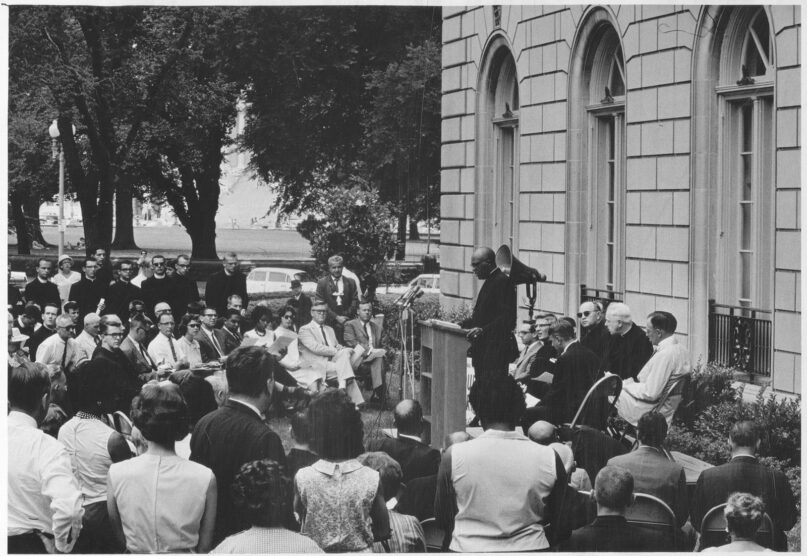
Some 200 Protestants, Roman Catholics and Jews joined in an interreligious thanksgiving service to mark the Senate passage of the Civil Rights Bill and to pledge continued efforts on behalf of racial justice, circa June 10, 1964. The service was held on the lawn of the United Methodist Building in Washington, about a block from the Capitol. Reading the Scripture is Bishop Henry C. Bunton of the Christian Methodist Episcopal Church. (RNS archive photo by the National Council of Churches. Photo courtesy of the Presbyterian Historical Society.)
In addition, in 1965, Bishop John Wesley Lord — who was deeply involved with the Civil Rights Movement and marched with Martin Luther King Jr. — returned to the Methodist Building to “wait over the implementation of racial justice within the life of the Methodist Church and the ongoing struggle for economic and racial justice in our wider society,” according to McCubbin.
The building also features apartments, some of which have been rented to U.S. senators and representatives who desired close access to the Capitol.
A hub for ecumenical and even interfaith organization and activism over the years, today the United Methodist Building hosts offices for multiple mainline Christian denominations such as the Episcopal Church, the Presbyterian Church (U.S.A.) and the United Church of Christ. Other groups that office there include Lutheran Services of America, Church World Service and the Islamic Society of North America.
In an interview with RNS, Hill, who has worked in the building for more than two decades, said recent years have seen the building become a launching pad for various kinds of activism.
The building has been “instrumental” in movements for “peace and justice, a gathering spot for strategizing, for building consensus, and then for going across the street to either do public witness or do direct advocacy with decision makers,” Hill said. It hosted a demonstration in support of the 2018 March for Our Lives protest for gun control legislation, for instance, and was recently the site of a prayer vigil calling for a cease-fire in Gaza and organized by Churches for Middle East Peace.
Hill remembers too when staff huddled in the building and observed the Jan. 6, 2021, attack on the U.S. Capitol.
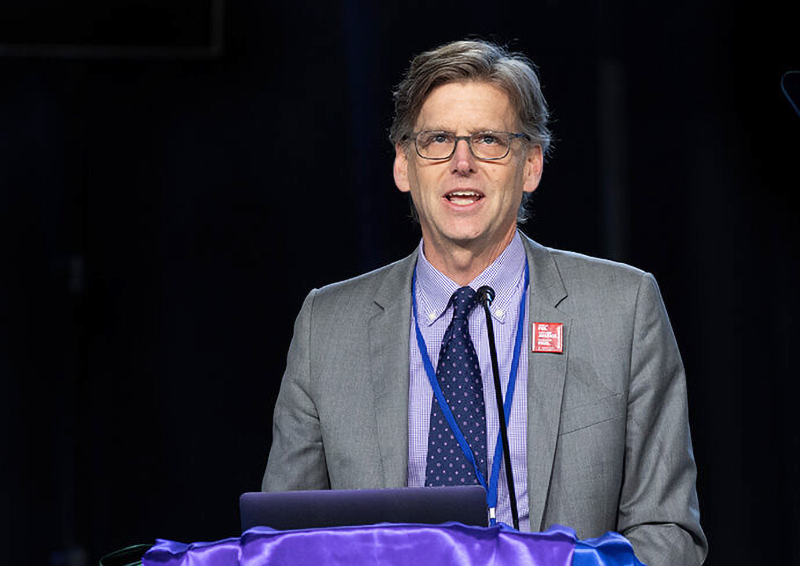
John Hill, then-interim general secretary of the Board of Church and Society, addresses the 2024 United Methodist General Conference in Charlotte, N.C. (Photo by Mike DuBose, UM News)
“We had to make decisions about who needed to stay and and who needed to be sure to evacuate the premises,” Hill said, noting that the Methodist Building’s unusual location means its staff are often in “constant conversation” with U.S. Capitol Police and other law enforcement agencies, such as the U.S. Secret Service.
The building also provided a unique service on Sept. 11, 2001, when it remained open for prayer despite evacuations of nearby federal buildings amid fears the Capitol could be attacked. Capitol police officers were invited inside to contact loved ones.
Hill recalled when faith leaders held daily vigils in front of the building to advocate for a federal budget that “reflects the values and priorities of our society,” and when the building hosted a 24-hour vigil in support of the Affordable Care Act in 2017 amid a Republican-led effort to repeal the health care law.
“(A) former colleague and others on our staff were at the 3 a.m. shift, out there with flashlights,” he said. “Holding that vigil for 24 hours was pretty powerful.”
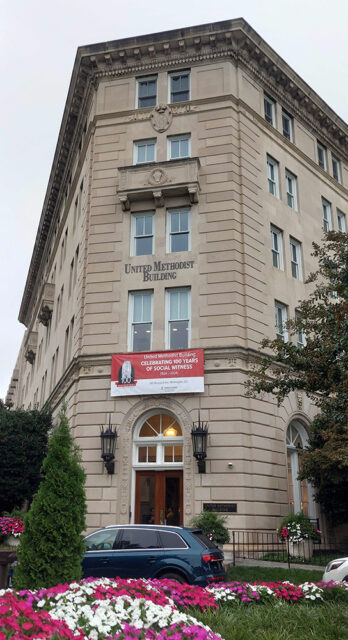
The 100th anniversary of the United Methodist Building is being celebrated in Washington, D.C. (RNS photo/Adelle M. Banks)
The building has also literally provided the backdrop to various major protests, such as when demonstrators flocked to the Supreme Court after justices overturned Roe v. Wade. The building had changed its sign after a draft of the decision leaked a month earlier, adding a message that read “Christ Values and Trusts Women. Follow Christ.”
Hill said what goes on the sign is decided by the group’s general secretary and communication staff. It has “always been an effective tool for witness and kind of public facing statements,” he said, adding that it strives to educate passersby on the “faith position” regarding various policies.
When Congress was debating potential voting rights legislation, the sign read: “Voting rights are sacred.” When tensions between the U.S. and Iran flared in May 2019, the sign read: “Diplomacy works. Support the Iran deal. No war with Iran.” And when outrage grew over the Trump administration’s family separation policy in summer of 2018, the sign’s message took on a sardonic tone, reading: “‘I was a stranger and you ripped my child from me,’ wait a second … ”
Granted, the building’s advocacy-minded mission hasn’t always sat well with all Methodists. In 2010, a group of Methodists filed suit, arguing the funds raised to construct the building and revenue earned from renters should be used only to fight alcoholism and support temperance. But a District of Columbia judge ruled against them, saying evidence presented at trial “clearly show that throughout the years, the Boards were also authorized to, and did, perform substantial work on other ‘public morals’ issues.”
For his part, Hill will be leaving the building this year, but said he departs hopeful the building will remain a place of forward-thinking advocacy for another century to come.
“I leave supremely confident that whatever the issues of the day are present, that this building, and the occupants of this building, and the folks who are connected to the work through this building, will be wrestling with those issues and working for justice,” he said.
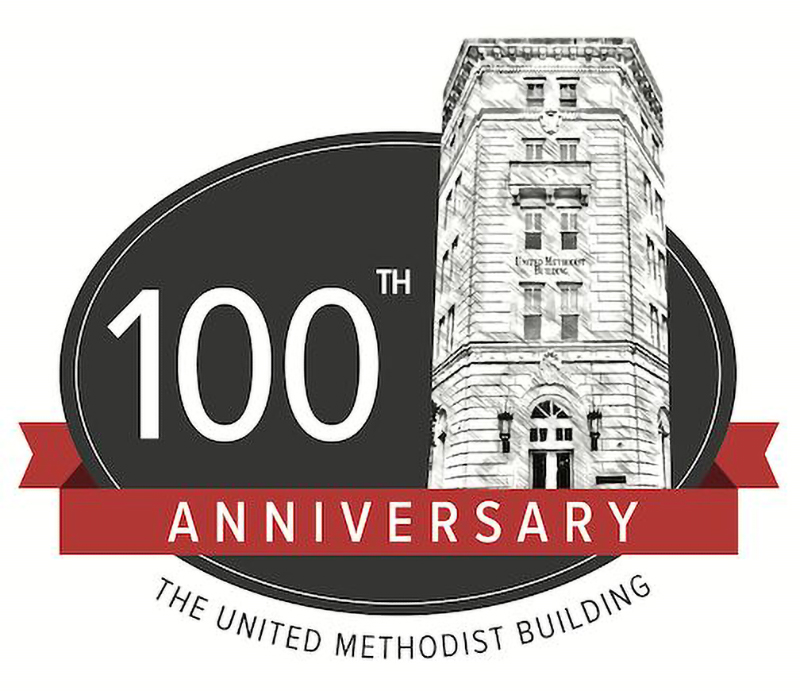
United Methodist Building 100th anniversary logo. (Courtesy image)
